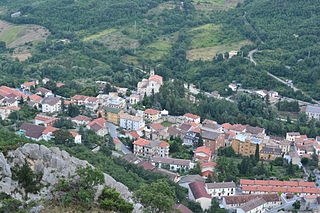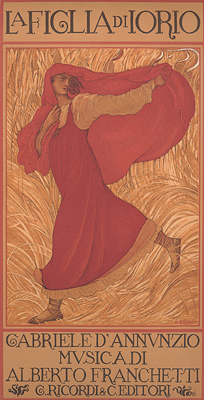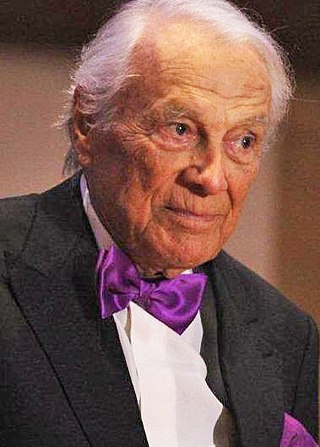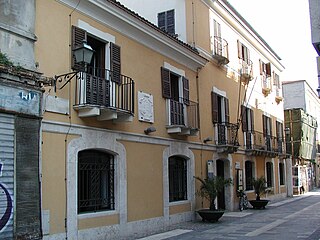
A libretto is the text used in, or intended for, an extended musical work such as an opera, operetta, masque, oratorio, cantata or musical. The term libretto is also sometimes used to refer to the text of major liturgical works, such as the Mass, requiem and sacred cantata, or the story line of a ballet.

General Gabriele D'Annunzio, Prince of Montenevoso, sometimes written d'Annunzio as he used to sign himself, was an Italian poet, playwright, orator, journalist, aristocrat, and Royal Italian Army officer during World War I. He occupied a prominent place in Italian literature from 1889 to 1910 and in its political life from 1914 to 1924. He was often referred to by the epithets il Vate and il Profeta.

Rigoletto is an opera in three acts by Giuseppe Verdi. The Italian libretto was written by Francesco Maria Piave based on the 1832 play Le roi s'amuse by Victor Hugo. Despite serious initial problems with the Austrian censors who had control over northern Italian theatres at the time, the opera had a triumphant premiere at La Fenice in Venice on 11 March 1851.

Giovanni Zenatello was an Italian opera singer. Born in Verona, he enjoyed an international career as a dramatic tenor of the first rank. Otello became his most famous operatic role but his repertoire also included French roles. In 1904, he created the part of Pinkerton in Madama Butterfly.

Francesca da Rimini or Francesca da Polenta was an Italian medieval noblewoman of Ravenna, who was murdered by her husband, Giovanni Malatesta, upon his discovery of her affair with his brother, Paolo Malatesta. She was a contemporary of Dante Alighieri, who portrayed her as a character in the Divine Comedy.

Ildebrando Pizzetti was an Italian composer of classical music, as well as being a musicologist and a music critic.

La nave is an opera in a prologue and three "episodes" by Italian composer Italo Montemezzi. Its Italian-language libretto was adapted by Tito Ricordi from Gabriele D'Annunzio's 1908 play of the same name. It premiered at La Scala in Milan on 3 November 1918.

Taranta Peligna is a comune and town in the province of Chieti in the Abruzzo region of central Italy. It is 57 kilometres (35 mi) from Chieti.
Literaturoper, a term coined by the German music critic Edgar Istel, describes a genre of opera that emerged during the late 19th century. When an existing play for the legitimate theatre is set to music without major changes and without the intervention of a librettist, a “Literaturoper” is the result. Although the term is German, it can be applied to any kind of opera, irrespective of style or language.

La figlia di Iorio, sometimes written as La figlia di Jorio, is an opera in three acts by Alberto Franchetti to a libretto by Gabriele D'Annunzio. The libretto is a very close rendering of D'Annunzio's play of the same name. La figlia di Iorio premiered at La Scala on 29 March 1906, conducted by Leopoldo Mugnone. Although the play, which had premiered two years earlier, was considered one of D'Annunzio's greatest works, the opera did not achieve a comparable success and has been rarely performed since its day.

The Grotta del Cavallone, also known as the Grotta della Figlia di Jorio, is a cave located near Lama dei Peligni in Taranta Peligna, in the province of Chieti, Abruzzo, Italy. It is open during the warmer months; an admission fee is charged.

Lyda Cini, Countess of Monselice was an Italian actress of cinema and theatre. Her career in theatre started when she was a child, acting on stage with Paola Pezzaglia in the French drama I due derelitti.

Mirto Picchi was an Italian dramatic tenor, particularly associated with the Italian repertory, and with contemporary works.

Leopoldo Mugnone was an Italian conductor, especially of opera, whose most famous work was done in the period 1890–1920, both in Europe and South America. He conducted various operatic premieres, and was also a composer of operas.

Eugenio Giraldoni was an Italian operatic baritone who enjoyed a substantial international career. In 1900, he created the role of Baron Scarpia in Giacomo Puccini's Tosca.
Iorio is an Italian surname. Notable people with the surname include:

Giovacchino Forzano was an Italian playwright, librettist, stage and film director. A resourceful writer, he authored numerous popular plays and produced opera librettos for most of the major Italian composers of the early twentieth century, including the librettos for Giacomo Puccini's Suor Angelica and Gianni Schicchi.

Giorgio Albertazzi was an Italian actor and film director.
"Bella figlia dell'amore" is a vocal quartet from the last act of Giuseppe Verdi's 1851 opera Rigoletto.

The Gabriele d'Annunzio Birthplace Museum is located at 116 Corso Manthoné in Pescara and was declared a national monument in 1927. Since December 2014, the Ministry of Cultural Heritage and Activities has managed it through the Polo Museale dell'Abruzzo, which became the Regional Directorate of Museums in December 2019.

















